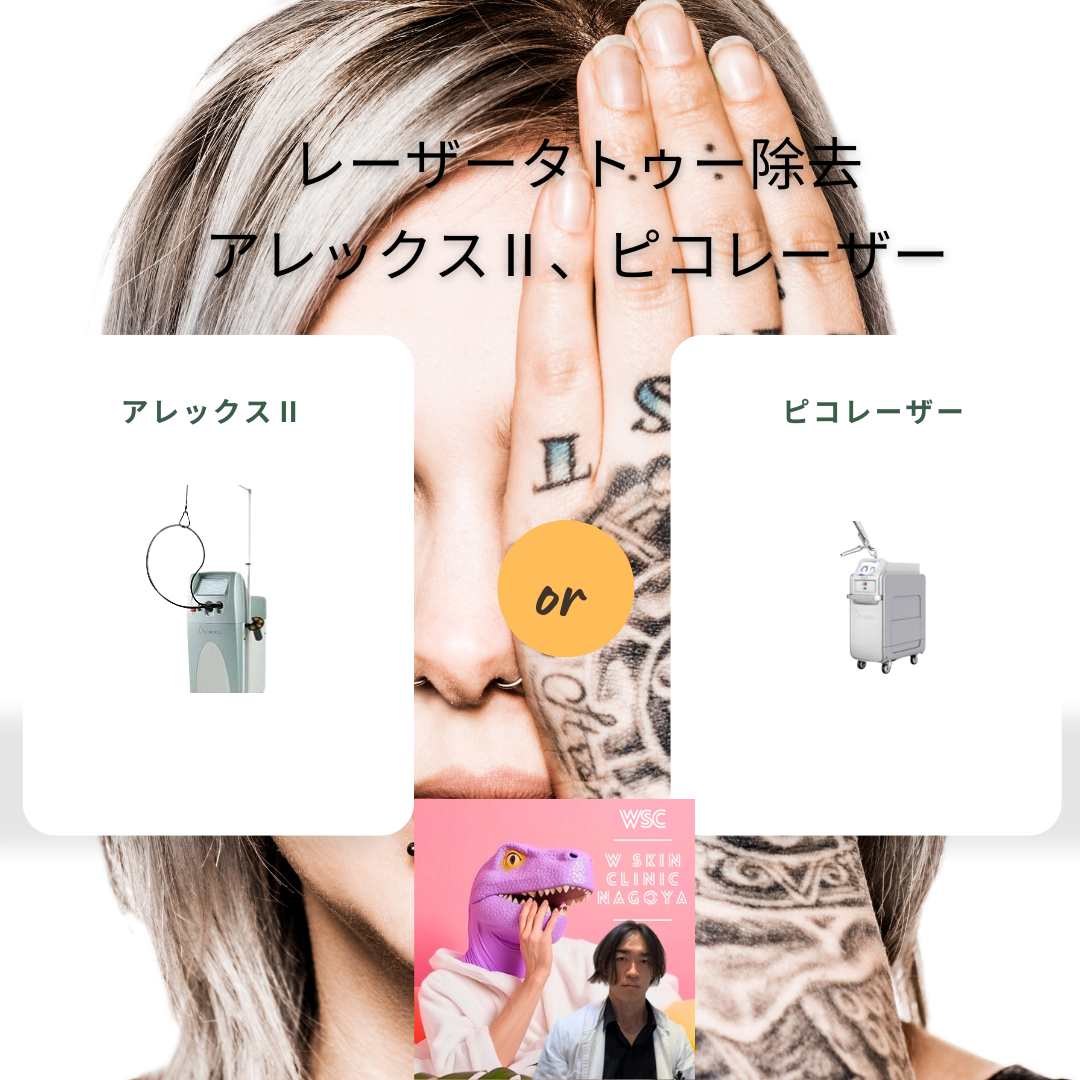NEWSお知らせ
2024.08.23|ブログ
レーザータトゥー除去、アレックスⅡとピコレーザーの違いについて、名古屋の美容皮膚科医が解説

レーザータトゥー除去、アレックスⅡとピコレーザーの違いについて、名古屋の美容皮膚科医が解説
こんにちは、Wスキンクリニック名古屋、院長の加藤晃司です。
今回は、レーザータトゥー除去、アレックスⅡとピコレーザーの違いについて解説します。
レーザーを使用したタトゥー除去には、さまざまな技術がありますが、その中でもアレックスⅡとピコレーザーは一般的に使用される方法です。それぞれの技術には、特定の特性や利点があります。以下に、アレックスⅡとピコレーザーの違いを説明します。
(1)アレックスⅡレーザー(Alexandrite Laser)
①特徴
アレックスⅡは、アレキサンドライトレーザーを使用したタトゥー除去システムです。このレーザーは755nmの波長を持ち、特に青や黒の色素に対して効果的です。
主に、ナノ秒(ns)単位のパルスを用いて色素を破壊します。
②メカニズム
選択的光熱分解:アレキサンドライトレーザーは、特定の色素(主に黒や青)に吸収され、そのエネルギーが色素を熱で破壊します。破壊された色素は、体の自然な代謝プロセスを通じて徐々に排出されます。
③効果
色素選択性:特に青や黒のタトゥーに対して高い効果があります。ただし、赤や黄色などの明るい色には効果が限定的です。
回数:色素が濃いタトゥーでは、複数回の治療が必要です。
ダウンタイムと副作用
ダウンタイム:治療後に皮膚が赤くなったり、腫れたりすることがありますが、通常は数日で治まります。
④副作用:色素脱失(皮膚が白くなる)や色素沈着(治療後に色が濃くなる)などが起こることがあります。
(2)ピコレーザー(PicoSure, PicoWayなど)
①特徴
ピコレーザーは、ピコ秒(ps)単位の非常に短いパルスを使用するレーザーです。ピコ秒レーザーは、従来のナノ秒レーザー(アレックスⅡなど)よりも短いパルスを用いることで、より精密に色素を破壊できます。
波長は1064nm、532nm、755nmなど、複数の波長が使用されることがあり、さまざまな色のタトゥーに対応できます。
②メカニズム
圧力波作用:ピコレーザーは、非常に短いパルスで強力な圧力波を発生させ、色素を細かい粒子に破砕します。これにより、体が色素をより速く効率的に排出できるようになります。
③効果
多色対応:ピコレーザーは、黒や青だけでなく、赤、黄色、緑など、幅広い色のタトゥーに効果を発揮します。
短い治療回数:従来のレーザーよりも色素破壊が効率的であるため、少ない回数でタトゥーを除去できることが多いです。
④ダウンタイムと副作用
ダウンタイム:ピコレーザーは皮膚へのダメージが少ないため、ダウンタイムが短く、通常の生活に早く戻ることができます。
副作用:従来のレーザーに比べて、副作用(色素沈着や色素脱失)のリスクが低いとされています。
(3)アレックスⅡとピコレーザーの違い
パルス時間:
アレックスⅡ:ナノ秒(ns)単位のパルスを使用。
ピコレーザー:ピコ秒(ps)単位の非常に短いパルスを使用。
色素への効果:
アレックスⅡ:特に黒や青の色素に効果的だが、明るい色には効果が限定的。
ピコレーザー:黒、青、赤、緑、黄色など、幅広い色のタトゥーに効果を発揮。
治療回数:
アレックスⅡ:色素が濃いタトゥーの場合、複数回の治療が必要。
ピコレーザー:効率的に色素を破壊できるため、少ない回数で効果を得られることが多い。
副作用:
アレックスⅡ:色素脱失や色素沈着のリスクがある。
ピコレーザー:皮膚へのダメージが少なく、副作用のリスクが低い。
まとめ
アレックスⅡは、特に黒や青の色素に対して効果的なナノ秒レーザーで、シンプルな色のタトゥー除去に向いています。ピコレーザーは、より短いピコ秒のパルスを使用し、幅広い色のタトゥーに対応可能で、治療回数が少なく、ダウンタイムも短いことが特徴です。
タトゥー除去を検討する際は、タトゥーの色、濃さ、治療回数、ダウンタイムなどを考慮し、最適な方法を選択することが重要です。
Wスキンクリニック名古屋での、ピコレーザーによるタトゥー除去はこちら
https://www.w-clinic-nagoya.com/tattoo-removal
Wスキンクリニック名古屋
理事長 加藤晃司
当院では無料でスタッフカウンセリングを行なっております。
お気軽にご予約くださいませ
Wスキンクリニック名古屋 (美容皮膚科)
https://www.w-clinic-nagoya.com/
〒461-0005 愛知県名古屋市東区東桜 2-4-1 第3コジマビル6F
TEL 052-7377-7117(10:00~19:00)
LINE ID @w.nagoya
高岳駅より徒歩4分 / 新栄町駅より徒歩5分
お車でお越しの方
名鉄協商パーキングチケットをお渡しいたしますので、クリニック近くのパーキングをご利用ください。
Explanation by a Dermatologist in Nagoya on the Differences Between Laser Tattoo Removal Using Alex II and Pico Laser
Hello, I’m Koji Kato, the director of W Skin Clinic Nagoya.
Today, I will explain the differences between laser tattoo removal using Alex II and Pico Laser.
Laser tattoo removal involves various technologies, with Alex II and Pico Laser being among the most commonly used methods. Each of these technologies has specific characteristics and advantages. Below, I will explain the differences between Alex II and Pico Laser.
- Alex II Laser (Alexandrite Laser)
Features:
Alex II uses an Alexandrite laser system for tattoo removal. This laser operates at a wavelength of 755nm, making it particularly effective for blue and black pigments. It primarily uses nanosecond (ns) pulses to break down the pigments.
Mechanism:
Selective Photothermolysis: The Alexandrite laser targets specific pigments (mainly black and blue) by being absorbed by these colors, and the energy generated heats and destroys the pigment. The destroyed pigment is then gradually eliminated through the body's natural metabolic processes.
Effectiveness:
Pigment Selectivity: It is highly effective for black and blue tattoos. However, its effectiveness is limited for lighter colors such as red and yellow.
Number of Treatments: Multiple sessions are typically required for tattoos with dense pigments.
Downtime and Side Effects:
Downtime: After treatment, the skin may become red or swollen, but this usually subsides within a few days.
Side Effects: Risks include hypopigmentation (skin whitening) or hyperpigmentation (darkening of the treated area).
- Pico Laser (PicoSure, PicoWay, etc.)
Features:
Pico Laser uses ultra-short picosecond (ps) pulses. Unlike traditional nanosecond lasers (like Alex II), the picosecond laser provides more precise pigment destruction. Pico lasers can operate at wavelengths of 1064nm, 532nm, and 755nm, making them versatile for treating various tattoo colors.
Mechanism:
Pressure Wave Effect: The Pico Laser generates strong pressure waves with its ultra-short pulses, breaking down the pigment into smaller particles. This allows the body to remove the pigment more quickly and efficiently.
Effectiveness:
Multi-Color Capability: Pico Laser is effective on a wide range of tattoo colors, including black, blue, red, yellow, and green.
Fewer Treatments: Due to its efficiency in breaking down pigment, fewer treatment sessions are often needed compared to traditional lasers.
Downtime and Side Effects:
Downtime: Pico Laser causes less skin damage, resulting in shorter downtime and quicker return to normal activities.
Side Effects: Pico Laser is associated with a lower risk of side effects, such as hyperpigmentation or hypopigmentation, compared to traditional lasers.
- Differences Between Alex II and Pico Laser
Pulse Duration:
Alex II: Uses nanosecond (ns) pulses.
Pico Laser: Uses ultra-short picosecond (ps) pulses.
Effectiveness on Pigments:
Alex II: Highly effective on black and blue pigments but less effective on lighter colors.
Pico Laser: Effective on a wide range of tattoo colors, including black, blue, red, green, and yellow.
Number of Treatments:
Alex II: Multiple sessions may be required for dense tattoos.
Pico Laser: Generally requires fewer sessions due to its efficiency in pigment destruction.
Side Effects:
Alex II: Risks include hypopigmentation and hyperpigmentation.
Pico Laser: Lower risk of skin damage and side effects.
Conclusion
Alex II is a nanosecond laser particularly effective for black and blue pigments, making it suitable for simpler tattoo removal. Pico Laser, on the other hand, uses shorter picosecond pulses, is capable of treating a wider range of tattoo colors, requires fewer treatments, and has shorter downtime.
When considering tattoo removal, it is important to choose the most suitable method based on factors such as tattoo color, density, number of treatments, and downtime.




